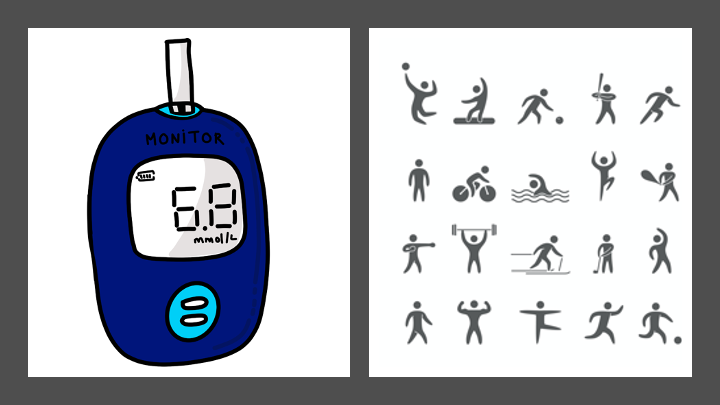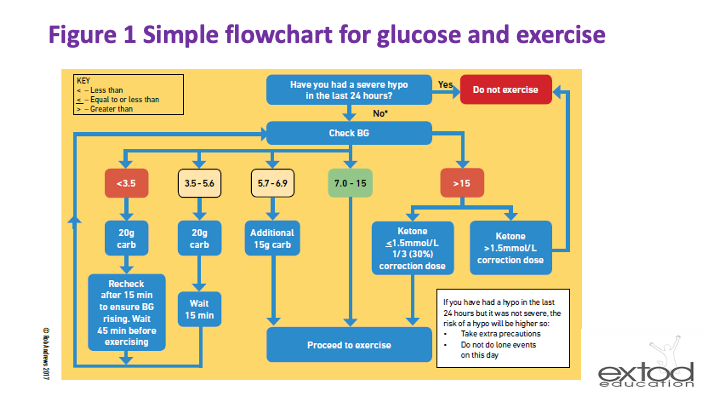 Advice for Professionals
Advice for Professionals

Blood glucose and exercise for adults with T1D
Checking blood glucoses
Checking blood glucoses and recording these are key to good control of blood glucose during exercise. Blood glucoses should be tested at three time points;
- Before - two blood glucoses should be taken at least 10 minutes apart before exercise so that the starting glucose is known as well as the direction in which the blood glucose is going.
- During – if possible blood glucose should be checked every 30 minutes during exercise.
- After – blood glucose should be checked on finishing, an hour later and 6 hours later (or prior to bed). If the patient has done a new exercise or exercise for longer than 2 hours then blood glucose should be checked at 3 am.
Optimum blood glucose for exercise
During aerobic exercise blood glucose is held within a tight range of between 3.9-6.1 mmol/l (70-110 mg/dL) in individuals without diabetes in almost all forms of exercise regardless of intensity and duration (Raguso et al., 1995). If the blood glucose falls below 3.9 mmol then co-ordination and ability to do exercise is impaired. Thus, blood glucoses below 3.9 should be avoided. Similar when blood glucose rises above 15, patients can run into difficulty with dehydration and risk of ketoacidosis and may also see a reduction in their performance. For these reasons exercising with a blood glucose of 15 mmol/l should be avoided (see below).
There is little research exploring how exercise performance changes as the glucose rises above 6 and towards 15 mmol/l. People with type one diabetes tell us that their performance suffers when their glucose rises, particularly if it is greater than 12 mmol/L.
The treatment goal for glucose levels during exercise in T1D is to maintain glucose levels as close to physiologically normal as possible whilst avoiding dangerously low blood glucoses (less than 3.9 mmol/l) or high blood glucoses (greater than 15 mmol/l). In our experience, which is backed up by a study in adolescents, to get the best performance blood glucose should be maintained between 6-8mmol/l (Kelly D, Hamilton JK, Riddell MC. Blood glucose levels and performance in a
Blood glucoses that say no
There are some blood glucoses that are associated with higher risk when exercising. We suggest when these blood glucoses are seen that exercise should not be undertaken.
Hypoglycaemia
Hypoglycaemia in the 24 hours preceding exercise blunts the counter-regulatory hormone response to exercise-induced hypoglycaemia. This means that an individual is at greater risk of (exercise induced) hypoglycaemia following an episode of hypoglycaemia. This risk is proportional to the severity of the preceding hypoglycaemia, with the effect starting at 3.9 mmol/l [11]. We suggest;
- Not to exercise within 24 hours of severe hypoglycaemia (low blood glucose requiring third party assistance).
- Not to exercise within 1 hour of self-treated hypoglycaemia. If an individual insists on doing so, he/she should treat the hypoglycaemia and wait 45-60 mins once glucose stable before commencing activity.
- Take extra precautions when there has been an episode of self-treated hypoglycaemia within the previous 24 hours. This would include more frequent glucose testing, exercising with an informed partner, and if possible including an anaerobic component to their training because this will tend to raise their blood glucose.
If there is hypoglycaemia during exercise, exercise should be discontinued and the hypoglycaemia treated. The individual should wait at least 45 mins before recommencing activity (or until blood sugars are stable). If an episode of severe hypoglycaemia occurs during exercise, then the activity should be stopped altogether due to the high risk of further hypoglycaemia.
Hyperglycaemia
When the blood glucose level is greater than 15mmol/l before exercise, a check should be made for the presence of ketones (ideally this should be capillary blood ketones). If blood ketones are greater than 1.5 mmol/L, then the patient should take a 1/3 (30%) of their normal correction dose and then wait until the ketones have fallen below 1.5 mmol/L and their blood glucose is below 15 mmol/L before exercising. If ketones are less than or equal to 1.5 mmol/L then again insulin may need to be taken before starting exercise, depending on when the patient last ate (see table below).
If the patient cannot measure their blood ketones, we suggest they take a 1/3 (30%) of their normal correction dose and then wait until their blood glucose is below 15 mmol/L before exercising and suggest they do not do anaerobic exercise on that day.
The table below shows the blood sugars that say No to exercise

What to do with a blood glucose reading just before exercise
Figure 1 is a flow sheet that shows what should be done with each blood glucose before exercise for people using capillary blood glucose monitoring. This is a starting point and then can be adapted dependent on response.

Figure 2 is a flow sheet that is a flow sheet that shows what should be done with each blood glucose before exercise for people using continuous glucose monitoring or flash glucose monitoring. This is a starting point and then can be adapted dependent on response.

Please go to the download section to download these flow diagrams
